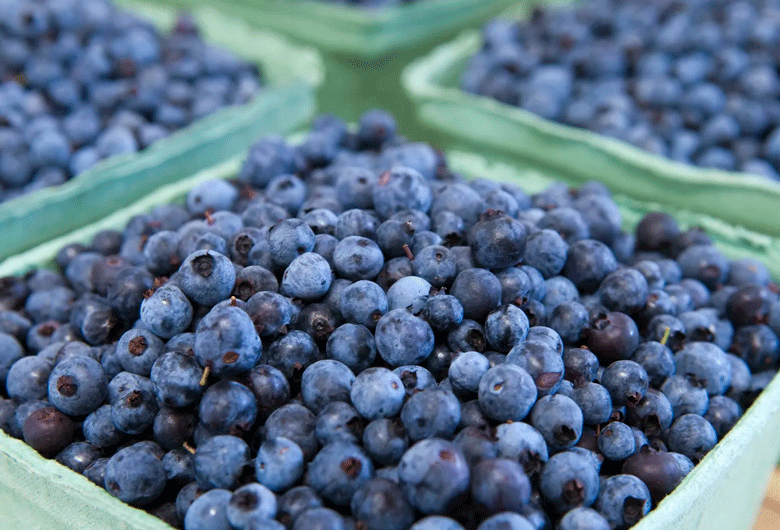Honeybees play an integral role in the pollination of Maine’s wild blueberries, and most of them spend their winters in the South. So when news broke that Hurricane Ian destroyed upwards of 150,000 Florida hives last September, many Mainers wondered—will the blueberries be OK?
The answer is yes, says Lincoln Sennett, owner of Maine’s largest beekeeping company, Swan’s Honey.
“We actually winter our bees in south Georgia,” said Sennett, speaking from the American Beekeeping Federation Conference held in Florida last month. “That topic of the hive losses has come up here. There are people struggling, but it won’t impact blueberry pollination.”
Native pollinators like the bumblebee play a large role in wild blueberry production, contributing around 40 percent of the effort.
Hurricane Ian, a Category 4 storm with sustained winds greater than 155 mph, passed over 15 percent of the nation’s hives, delivering financial losses and wreaking havoc for beekeepers. Steve Alderman, who in years past delivered his bees from Florida to Washington County each spring, now assists a Florida beekeeper who lost 500 hives in the storm.
“And we lost a big contract in California because we couldn’t split the bees,” said Alderman. “By splitting them off, that 500 hives might have made 1,000 or 1,500 hives in just a few weeks.”
A beekeeper’s ability to generate more hives through splitting is one reason Maine’s blueberry crop is safe and sound—pollination won’t begin here until mid-May, leaving beekeepers plenty of time to recover.
But circumstances in California mean that not only blueberries but all of the nation’s crops will likely have enough honeybees to go around this year, even with Florida’s steep losses.
“The thing that is different this year is that the amount of [almond] acreage that requires pollination will stay level or drop, instead of expanding,” said Sennett. “You’ll have more bees chasing fewer acres.”
The majority of the nation’s hives—2.1 million last year—are transported to California for the start of almond pollination season, usually around Valentine’s Day. As beekeeping conference attendees learned last month, a drop in almond prices against the backdrop of California’s drought means that almond production could scale back in 2023, leaving some bees looking for work.
California’s almond industry is the single largest pollination event in the nation, but Maine State Apiarist Jennifer Lund believes Maine blueberries could be the second largest, or at least in the top four. She agrees with Sennett that Maine growers won’t be at a loss for bees this year.
“We get about 50,000 hives that come up for blueberry pollination and a lot of ours do come out of Florida, but by then they will have built back up,” said Lund, also speaking from a beekeeping event in Florida, the annual meeting of the Apiary Inspectors of America.
Soon Lund’s office will begin preparations to receive those 50,000 hives for Maine’s blueberry pollination season, which begins when blueberries begin to blossom in May and lasts for about three weeks.
Native pollinators like the bumblebee also play a large role in wild blueberry production, says Lund, contributing around 40 percent of the effort. And because the bumblebee has “co-evolved” alongside the wild blueberry, unlike the honeybee which originates in Europe, the bumblebee is extremely efficient. Using a technique called “buzz pollination,” one bumblebee can fully pollinate a blueberry blossom in about two trips, whereas a honeybee might need 12.
“The bumblebee will hang upside down from the flower, then vibrate its body at a certain frequency to release the pollen and nectar, which falls on their undersides,” said Lund. “And then they bring it back to the nest.”
Tim and Lydia Beal, who co-manage Josh Pond Farm in Whiting, rent honeybees to pollinate their organic wild blueberries, but have also supplemented with bumblebees in the past. They would do it again if honeybees became scarce, but from a business perspective, honeybees make the most sense.
“With honeybees, you can get this large volume of pollinators,” said Lydia. “Bumblebees are more equipped to get into the blossom than the honeybee and very efficient, but you don’t rent them, you buy them, and they are very expensive,” she added.
“You really see an uptick in pounds per acre with honeybee pollination,” said Tim, who estimates honeybees increase Josh Pond’s per-acre production by as much as 33 percent.
Dr. John Gaddis, who manages his family’s Downeast blueberry land, rents Swan’s honeybees to pollinate his berries and agrees that honeybees increase his crop.
“Some people don’t want to spend the money but those who do usually find that they get a better yield, the bees pay for themselves,” said Gaddis.
If he couldn’t get honeybees from Swan’s, Gaddis says he’d work hard to find them somewhere else, because they’re superior pollinators. But he doesn’t have to worry this year, says Sennett.
“There are going to be plenty of bees that will be happy to get a pollination contract because some of those bees aren’t going to get one in California,” Sennett said. “Overall, I’d say the total number of colonies is holding good now. Beekeepers are getting better at managing and mitigating stressors for honeybees, and things are looking positive.”





